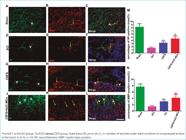SUMMARY
OBJECTIVE:
This study aimed to assess the effect of the collagen/silk fibroin scaffolds seeded with human umbilical cord-mesenchymal stem cells on functional recovery after acute complete spinal cord injury.
METHODS:
The fibroin and collagen were mixed (mass ratio, 3:7), and the composite scaffolds were produced. Forty rats were randomly divided into the Sham group (without spinal cord injury), spinal cord injury group (spinal cord transection without any implantation), collagen/silk fibroin scaffolds group (spinal cord transection with implantation of the collagen/silk fibroin scaffolds), and collagen/silk fibroin scaffolds + human umbilical cord-mesenchymal stem cells group (spinal cord transection with the implantation of the collagen/silk fibroin scaffolds co-cultured with human umbilical cord-mesenchymal stem cells). Motor evoked potential, Basso-Beattie-Bresnahan scale, modified Bielschowsky's silver staining, and immunofluorescence staining were performed.
RESULTS:
The BBB scores in the collagen/silk fibroin scaffolds + human umbilical cord-mesenchymal stem cells group were significantly higher than those in the spinal cord injury and collagen/silk fibroin scaffolds groups (p<0.05 or p<0.01). The amplitude and latency were markedly improved in the collagen/silk fibroin scaffolds + human umbilical cord-mesenchymal stem cells group compared with the spinal cord injury and collagen/silk fibroin scaffolds groups (p<0.05 or p<0.01). Meanwhile, compared to the spinal cord injury and collagen/silk fibroin scaffolds groups, more neurofilament positive nerve fiber ensheathed by myelin basic protein positive structure at the injury site were observed in the collagen/silk fibroin scaffolds + human umbilical cord-mesenchymal stem cells group (p<0.01, p<0.05). The results of Bielschowsky's silver staining indicated more nerve fibers was observed at the lesion site in the collagen/silk fibroin scaffolds + human umbilical cord-mesenchymal stem cells group compared with the spinal cord injury and collagen/silk fibroin scaffolds groups (p<0.01, p< 0.05).
CONCLUSION:
The results demonstrated that the transplantation of human umbilical cord-mesenchymal stem cells on a collagen/silk fibroin scaffolds could promote nerve regeneration, and recovery of neurological function after acute spinal cord injury.
KEYWORDS:
Rats; Collagen; Silk fibroin; human mesenchymal stem cells; Nerve regeneration; Spinal cord injuries

 Thumbnail
Thumbnail
 Thumbnail
Thumbnail
 Thumbnail
Thumbnail


